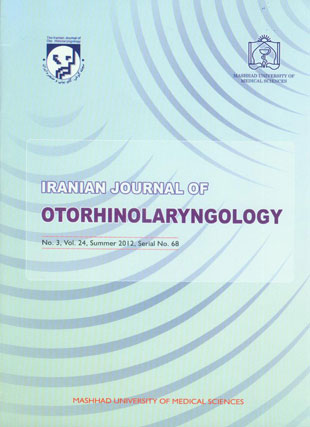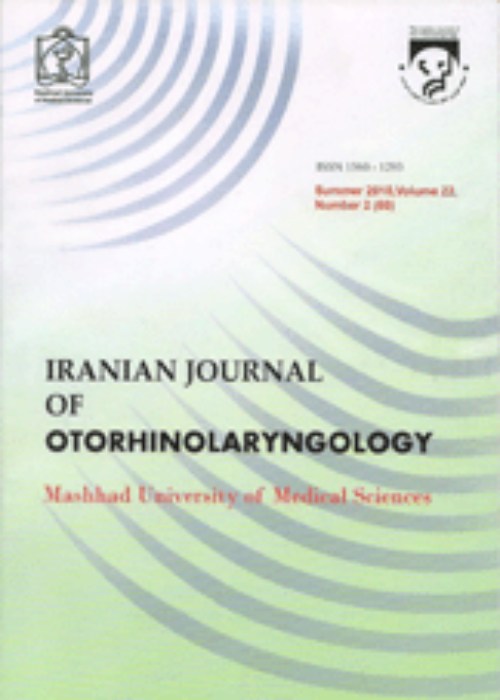فهرست مطالب

Iranian Journal of Otorhinolaryngology
Volume:24 Issue: 3, Summer 2012
- تاریخ انتشار: 1391/01/21
- تعداد عناوین: 9
-
-
Pages 105-111IntroductionThe use of cartilage as a grafting material has been advocated in cases where there is a high risk of graft failure, such as subtotal perforations, adhesive processes, and residual defects after primary tympanoplasties. The purpose of this study was to compare the graft acceptance rates and auditory outcomes of cartilage tympanoplasty operations using a palisade technique with those of primary tympanoplasty using temporalis fascia in a homogenous group of patients. Study Design: Prospective study.Materials And MethodsThe study population included 54 patients who were operated on in two groups (palisade technique & temporalis fascia technique) with each group containing 27 patients. Patients with pure subtotal perforations (perforation of >50% of the whole tympanic membrane [TM] area), an intact ossicular chain, at least a one month dry period, and normal middle ear mucosa were included in the study. Grafts acceptance rates and pre- and post-operative audiograms were compared. The follow-up time was six months.ResultsGraft acceptance was achieved in all patients (100%) in the palisade cartilage tympanoplasty group and in 25 patients (92.5%) in the temporalis fascia group. This difference was not statistically significant (P= 0.15). Comparison of the increases in mean speech reception threshold, air–bone gap, and pure-tone average scores between both techniques showed no significant changes.ConclusionOur experience with the palisade cartilage technique demonstrates that subtotal or total perforation at high risk for graft failure can be treated efficiently, and that a durable and resistant reconstruction of the TM with reasonable auditory function can be achieved.
-
Pages 113-118IntroductionAs one of the most common cancers among head and neck malignancies, cancer of the oral cavity probably has some variations in countries with a high prevalence of esophageal cancer.Materials And MethodsPatients with oral cavity cancer who were treated at two tertiary referral centers from January 1999 to January 2009 were included in this study. In addition to demographic data, information regarding personal and family history of head and neck cancer, use of dentures, presence of immune deficiency, consumption of alcohol, and incidence of cigarette smoking was collected. Additionally, a history of opium usage was obtained from the participants in this study. Moreover, an appropriately matched control group was selected for comparisons between the risk factors.ResultsA total of 557 patients were entered into this study over a 10-year period, of whom 219 (39.3%) were female and the remaining 338 (60.7%) were male. The tongue was the most common site of cancer and 9% of the patients had a history of opium abuse, but more than half of the patients did not have any recognized risk factors. The incidence and stage of cancer had a significant relationship with cigarette smoking (P=0.013).ConclusionTongue cancer in non-smokers is the predominant pattern of oral cavity cancer in Iran.
-
Pages 119-124IntroductionHigh prevalence of rhinoplasty in the community and lack of structured studies about its minor skin and soft tissue complications, point out the necessity of performing precise and comprehensive studies. The aim of this study was to determine the frequency of minor cutaneous and soft tissue complications of rhinoplasty.Materials And Methods110 patients (30 Male and 80 Female, Mean age: 26.3± 6.8) participated in this study. Before surgery all of them were checked for having each of intended complications, and 1 and 3 months after the surgery, they underwent serial visits for monitoring skin & soft tissue complications. The software used for data analysis was SPSS ver.16.ResultsAcne exacerbation was seen in 27% of cases in first post-surgical visit. Nasal tip paresthesia was the most frequent complication in both postsurgical visits (49.6% in first and 36.3% in second visit), followed by eyebrow loss (31.8%), complaint of increased yawning (31.8%), periorbital hyperpigmentation (21.8%) in first visit, and, hyperpigmentation (19.1%), complaint of increased yawning (10%) and surgical site scar (7.2%) in second visit respectively. The frequency of complications was highest in younger than 25 year old age group.ConclusionHaving knowledge about these complications helps us to know which of them needs prompt medical intervention and which of them will resolve with time and just needs giving reassurance to the patient.
-
Pages 125-128IntroductionThe aim of this study was to evaluate the condition of the ossicular chain in patients requiring surgery for cholesteatoma.Materials And MethodsIn a retrospective analysis, the destruction of the individual and combined bony structures of the ear was described in 166 patients with cholesteatoma who went through surgery in our Otology Center between 2003 and 2009.ResultsTotal (55.4%) or partial (30.7%) erosion of the incus was the most common pathology. In some cases, the long process (25.9%) and the body of incus (4.8%) were also involved. Erosion of the stapes superstructure occurred more commonly than a total loss of the bone (40.9% vs. 25.9%). Erosion of the malleus was least common. Completely intact ossicles were present in 5.5% of cases. Total ossicular erosion with an intact footplate (18.7%) and incudostapedial erosion (18%) was the most common combination of ossicular erosion. All patients with incudostapedial erosion had advanced disease (85% with multiple site involvement).ConclusionWidespread cholesteatoma results in greater ossicular erosion and poor hearing outcomes.
-
Pages 129-134IntroductionHearing is essential for humans to communicate with one another. Early diagnosis of hearing loss and intervention in neonates and infants can reduce developmental problems. The aim of the present study was to assess the prevalence of hearing impairment in newborns admitted to a neonatal intensive care unit (NICU) and analyze the associated risk factors.Materials And MethodsThis cross-sectional study was conducted to assess the prevalence of hearing loss in neonates who were admitted to the NICU at Nemazee Hospital, Shiraz University of Medical Sciences between January 2006 and January 2007. Auditory function was examined using otoacoustic emission (OAE) followed by auditory brainstem response (ABR) tests. Relevant potential risk factors were considered and neonates with a family history of hearing loss and craniofacial abnormality were excluded. For statistical analysis logistic regression, the chi-squared test, and Fisher’s exact test were used.ResultsAmong the 124 neonates included in the study, 17 (13.7%) showed hearing loss in the short term. There was a significant statistical relationship between gestational age of less than 36 weeks (P=0.013), antibiotic therapy (P= 0.033), oxygen therapy (P=0.04), and hearing loss. On the contrary, there was no significant relationship between hearing loss and use of a ventilator, or the presence of sepsis, hyperbilirubinemia, congenial heart disease, transient tachypnea of newborn, congenital pneumonia, or respiratory distress syndrome.ConclusionAuditory function in neonates who are admitted to a NICU, especially those treated with oxygen or antibiotics and those born prematurely, should be assessed during their stay in hospital. The importance of early diagnosis of hearing loss and intervention in these neonates and avoidance of any unnecessary oxygen or antibiotic therapy needs to be further promoted.
-
Pages 135-142IntroductionRhinoplasty is a popular cosmetic surgical procedure. Informal statistics show that Iran has one of the highest rates of rhinoplasty in the world. However, rhinoplasty like any other surgery can have complications.Materials And MethodsIn this cross-sectional study, 320 female students were selected by multistage cluster-stratified sampling from high schools in Kerman, Iran and each completed a questionnaire.ResultsMore than half of the students said they would like to undergo rhinoplasty. The main reasons for wanting rhinoplasty were beauty and because it is fashionable. However, more than half of the interested students did not know about the possible postoperative complications of rhinoplasty. There was no relation between interest in having rhinoplasty and parents’ education, city of birth or economic status.ConclusionMany teenagers are interested in having rhinoplasty in Iran. As the number of teenagers and young adults who choose to have cosmetic surgery increases, surgeons should consider their expectations, motivations and awareness of postoperative complications before surgery.
-
Pages 143-146IntroductionCoverage of bone grafts is very important in reconstructive surgery. In edentulous alveolar ridges this coverage is particularly important for supporting dental prostheses. Here we present the case of a patient with a large deficient maxillary anterior region that was reconstructed with a bilateral palatal submucosal periosteal connective tissue flap: a soft tissue reserve for upper jaw reconstructive surgeries. The bilateral pediculated palatal periosteal connective tissue flap was used for coverage of a large bone graft in the anterior maxillary region.
-
Pages 147-150IntroductionAn otogenic brain abscess is a common ENT problem but an otogenic trapezius abscess can also be experienced in otolaryngological practice, particularly in patients with chronic suppurative otitis media. Case Report: We report a rare case of a trapezius abscess in an eight-year-old girl who presented at the ENT, Head and Neck Surgery Postgraduate Medical Institute, Lady Reading Hospital, Peshawar, Pakistan on 15th December, 2010, with a presenting complaint of discharge from her right ear that had been occurring for the last five years. An exploration of the patient’s right ear was performed, which showed that there was extensive cholesteatoma and tissue granulation tissues the antrum, attic and middle ear. The trapezius abscess had spread down to her back and was repeatedly drained. The patient was discharged on the 14th day following admission after making a complete recovery. After a regular follow-up period the child has remained disease free. The rare nature of this case prompted us to write this report.ConclusionChronic suppurative otitis media is a common clinical problem in developing countries. It can result in a number of complications if not treated properly. Although an otogenic trapezius abscess is a rare complication of chronic suppurative otitis media, it must be kept in mind.
-
Page 151In this case report we present a rare case of a longstanding undetected foreign body in the pharynx. A 10-month-old girl presented with a history of vomiting and drooling. This complaint had first been noticed 50 days previously. It was noted that she had been diagnosed with upper respiratory or gastrointestinal tract infections several times during the previous 50 days and that symptomatic treatment had shown no benefits. The results of a physical examination were unremarkable and weight loss was only slight. Radiography of the neck region showed a metallic ring stuck to the pharyngeal wall (Fig. 1). The parents then reported that at the age of 8 months a golden ring went missing while the child was playing with it.


